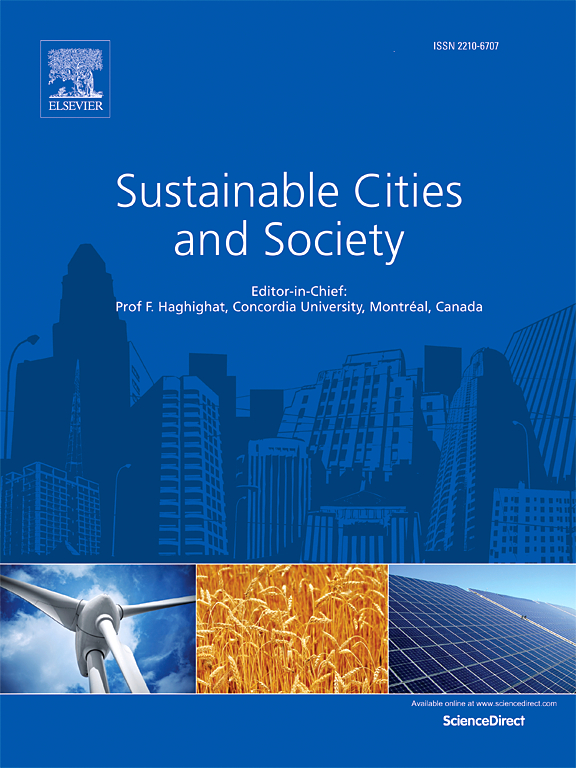从耐热性到可持续的协同效益:基于多模态数据融合和新的生成框架的适应性城市形态生成
IF 10.5
1区 工程技术
Q1 CONSTRUCTION & BUILDING TECHNOLOGY
引用次数: 0
摘要
快速城市化和全球气候变化加剧了城市热岛效应。然而,实际实施往往受到数据可用性和计算能力的限制,忽视了社会经济因素和空间异质性的影响。本研究通过新颖的CycleGAN-Pix2pix (CP-GAN)模型链,提出了一个端到端的城市三维形态生成框架,该框架利用多模态数据集,包括当地气候区(LCZ)、地表温度(LST)和人口密度(POPH)。以广州市6个具有代表性的低碳区为例,对不同响应生成情景下的城市形态指标(UMI)、土地利用和土地覆盖变化(LUCC)和兴趣点(POI)进行了评估,以确定能够平衡降温效应与社会经济和生态效益的城市形态。结果表明:(1)CP-GAN在城市形态生成中具有鲁棒性,收敛稳定,精度高,平均结构相似指数超过0.811,信噪比高,误差指标低。(2)气温升高重塑了城市形态,每升高3℃,城市绿地面积减少5.47%,商业活动和不透水地表面积分别增加2.38%和2.84%;(3)种群密度对POI聚类的控制作用弱于温度梯度。(4) LCZ4、LCZ5和LCZ6在UMI、LUCC和POI对温度和人口密度变化的响应上表现出空间异质性,表明LCZ4、LCZ5和LCZ6需要采取特定的适应策略。该生成系统提供了细粒度的3D形态解决方案,以减轻城市热岛效应,同时建立可持续城市发展的变革框架。本文章由计算机程序翻译,如有差异,请以英文原文为准。
From heat resilience to sustainable co-benefits: Adaptive urban morphology generation based on multimodal data fusion and a novel generative framework
Rapid urbanization and global climate change have intensified the Urban Heat Island (UHI) effect. However, practical implementation is often constrained by limitations in data availability and computational capacity, overlooking the influence of socioeconomic factors and spatial heterogeneity. This study proposed an end-to-end urban 3D morphology generation framework that leveraged multimodal datasets, including Local Climate Zones (LCZ), Land Surface Temperature (LST), and Population Density (POPH) through a novel CycleGAN-Pix2pix (CP-GAN) model chain. Using six representative LCZ areas in Guangzhou as case studies, the research evaluated the Urban Morphology Indicators (UMI), Land Use and Land Cover Change (LUCC), and Points of Interest (POI) across various responsive generation scenarios to identify urban morphologies that balanced cooling effects with socioeconomic and ecological benefits. The results showed that:(1) The CP-GAN achieved robust performance in urban morphology generation, demonstrating stable convergence and high precision, with an average structural similarity index exceeding 0.811, along with high signal-to-noise ratios and low error metrics. (2) Rising temperatures reshaped urban morphology, with every 3°C increase reducing green space by 5.47% while raising commercial activity and impervious surfaces by 2.38% and 2.84%, respectively; (3) Population density drove POI clustering but exhibited weaker morphological control than temperature gradients. (4) LCZ4, LCZ5, and LCZ6 exhibited spatial heterogeneity in UMI, LUCC, and POI responses to temperature and population density variations, necessitating LCZ-specific adaptive strategies. This generative system offers fine-grained 3D morphological solutions to mitigate UHI effects while establishing a transformative framework for sustainable urban development.
求助全文
通过发布文献求助,成功后即可免费获取论文全文。
去求助
来源期刊

Sustainable Cities and Society
Social Sciences-Geography, Planning and Development
CiteScore
22.00
自引率
13.70%
发文量
810
审稿时长
27 days
期刊介绍:
Sustainable Cities and Society (SCS) is an international journal that focuses on fundamental and applied research to promote environmentally sustainable and socially resilient cities. The journal welcomes cross-cutting, multi-disciplinary research in various areas, including:
1. Smart cities and resilient environments;
2. Alternative/clean energy sources, energy distribution, distributed energy generation, and energy demand reduction/management;
3. Monitoring and improving air quality in built environment and cities (e.g., healthy built environment and air quality management);
4. Energy efficient, low/zero carbon, and green buildings/communities;
5. Climate change mitigation and adaptation in urban environments;
6. Green infrastructure and BMPs;
7. Environmental Footprint accounting and management;
8. Urban agriculture and forestry;
9. ICT, smart grid and intelligent infrastructure;
10. Urban design/planning, regulations, legislation, certification, economics, and policy;
11. Social aspects, impacts and resiliency of cities;
12. Behavior monitoring, analysis and change within urban communities;
13. Health monitoring and improvement;
14. Nexus issues related to sustainable cities and societies;
15. Smart city governance;
16. Decision Support Systems for trade-off and uncertainty analysis for improved management of cities and society;
17. Big data, machine learning, and artificial intelligence applications and case studies;
18. Critical infrastructure protection, including security, privacy, forensics, and reliability issues of cyber-physical systems.
19. Water footprint reduction and urban water distribution, harvesting, treatment, reuse and management;
20. Waste reduction and recycling;
21. Wastewater collection, treatment and recycling;
22. Smart, clean and healthy transportation systems and infrastructure;
 求助内容:
求助内容: 应助结果提醒方式:
应助结果提醒方式:


